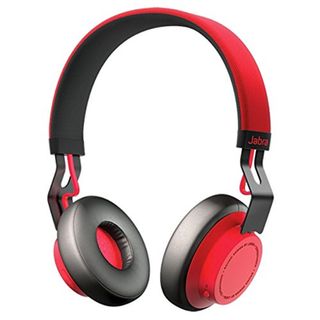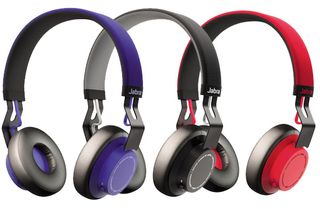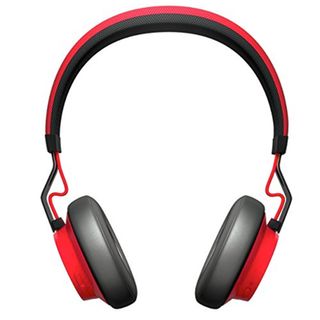Jabra Move Wireless Headphones Review
The Jabra Move Wireless Headphones offer accurate audio in a colorful design for a wallet-friendly price.
Why you can trust Tom's Guide

Who says you have to shell out exorbitant amounts of money for a good set of headphones? Jabra's Move Wireless headphones offer balanced audio in a lightweight durable frame with a pleasing pop of color -- all for $99. They're proof that sometimes you get more than you pay for.
Design
Given their aggressive price, the Move Wireless headphones are surprisingly fashionable. My favorite part of the design is the Cobalt (blue) and black headband. The color is striking, and I love rubbing my hands over the fabric. The headphones are also available in Coal (black) and Cayenne (red) for people who aren't too keen on Cobalt (blue). The band is dirt-resistant so you won't have to worry about unsightly buildup from sweat and grease.

The ends of the band and the yokes are made from smooth black stainless steel that connect to the plastic dark-blue housing. A microUSB port sits on the bottom of the right earcup with the power/Bluetooth pairing switch. The left side has a volume rocker and an audio jack. A button in the center of the rocker acts as a multifunction control, allowing you to skip tracks, play/pause music and answer/ignore calls. The earcups are comprised of a thin lining of memory foam wrapped in black leatherette.
MORE: The Best Headphones to Buy Now
Unfortunately, the headphones lack the ability to fold for easy storage. The band is fairly flexible so there shouldn't be any problems tossing the cans into a bag. According to Jabra, the headphones have been drop-tested from up to 3.2 feet and flexibility-tested up to 10,000 times.
Controls
The volume rocker performs double duty, allowing listeners to skip tracks without touching their mobile device. While it's a smart way to cut down on all the buttons, there were several times when I accidentally skipped a track when I meant to adjust the volume because I held a button too long.

Instead of employing quick taps for navigating tracks, you have to long press to skip forward or backward. That meant I had to repeatedly press the rocker to tweak the volume, which seemed counterintuitive.
The center multifunction button uses a quick press to activate play or pause, while a long press summons your phone's digital assistant (be it Siri, S Voice or Cortana). Double-tapping the button will answer or ignore an incoming phone call. If you're not using the phone, double-tapping will redial your most recent call.
Although the button functions are pretty easy to figure out, I do wish they were slightly larger and provided more bouncy feedback.
Comfort
Although the memory foam padding is fairly thin for my taste, the on-ear headphones rested comfortably on my ears for more than two hours. The Sync by 50s had a snugger fit and exerted more pressure.

Each set of headphones weigh a barely-there 5.6 ounces. However, the Moves' use of fabric instead of an all-plastic frame makes them feel a tad lighter when you're holding both in your hands.
Audio Cables
Similar to most Bluetooth headphones, the Moves come with a rubber audio cable and a microUSB cord for charging. The 3.5mm cable shipped with the headphones measures 48.1 inches.
Setup
Pairing the Moves with my Motorola Droid Maxx HD was a quick and painless process. After turning the headphones on, a pleasant female voice instructed me to go to the Bluetooth menu in Settings and select the Moves. From there, it took only 1-2 seconds to connect. The process was just as speedy on the iPhone 6 Plus and the HTC One M8 for Windows.
Passive Noise Cancellation
It's quiet, but not too quiet. The thin memory foam padding on the Move Wireless managed to blunt some of the noise I encountered on the New York City subway, but not all. Due to its lack of active noise-cancelling technology, the headphones could only slightly muffle the shouting match taking place at the other end of the car. I had to turn my music up to 20 to completely tune the racket out.

The Syncs by 50's Oval-Fit technology earcups did a better job of keeping the noise down. It didn't completely drown out the outside world like the Bose QuietComfort 25 headphones. However, I found that I didn't have to turn up my music quite as high to get a reprieve from the din around me.
Performance
Similar to most of its competitors, the Jabra Move Wireless headphones use 40mm drivers. However, the cans' proprietary Digital Signal Processor (DSP) enables the device to stand apart -- delivering clear, balanced audio you wouldn't expect from $99 headphones.
On George Michael's "Kissing A Fool," my ears were surrounded by a full-bodied piano, accompanied by crisp cymbals and a warm bass. The generous soundstage gave the horns plenty of room to breathe, not to mention Michael's plaintive vocal that blanketed me in feelings of longing and regret. The audio isn't as accurate as the AKG K495s, but it's impressive for the price.
The louder of the two headphones, the Syncs had no problem delivering fullness -- in fact, it oversold on the low-end, to its detriment. The overstuffed bass muddied the rest of the track.
When I switched to the boomtastic "Hustlin' (Remix)" by Rick Ross, the Move Wireless seemed a little bass-averse.
By contrast, the Sync by 50's drowned my ears in full-bodied lows. At least I could better enjoy the gritty vocals and otherworldly synthesized whistle on the Move.
Bluetooth/Battery Life
Jabra claims that the Move Wireless headphones will get up to 8 hours of talk time with approximately 12 days of standby time. The Sync by 50 headphones last 12 hours on a charge. Both sets of cans can play music when their batteries eventually die out.
The Bluetooth 4.0-equipped headphones have the typical 33-foot range expected from most wireless devices. However, I got a signal from 140 feet, which is fairly impressive.
Voice Calls
Since Jabra specializes in Bluetooth headsets, it's no surprise some of that know-how went into the Move Wireless. The end result is crystal-clear audio, which I and my test callers soon learned. The audio quality was good whether I called a smartphone or landline. However, two of my testers reported hearing faint hints of traffic as I walked around the city.
Bottom Line
Sometimes you don't have $300+ to plunk down on a pair of wireless headphones -- or you don't want to. For just $99, the Jabra Move gives music lovers a stylish, lightweight pair of headphones that deliver loud, fairly articulate audio with about 8 hours of battery life.
Fans of a more bass-heavy sound might want to save up for the $249 SMS Audio Sync by 50 On-Ear headphones. The high-gloss cans offer deep bass that hip-hop heads and EDM fanatics will appreciate with 12 hours of battery life. Still, the Move Wireless headphones are a great choice for music aficionados searching for durable, lightweight headphones with solid audio at a great price.
Sign up to get the BEST of Tom’s Guide direct to your inbox.
Upgrade your life with a daily dose of the biggest tech news, lifestyle hacks and our curated analysis. Be the first to know about cutting-edge gadgets and the hottest deals.
Sherri L. Smith has been cranking out product reviews for Laptopmag.com since 2011. In that time, she's reviewed more than her share of laptops, tablets, smartphones and everything in between. The resident gamer and audio junkie, Sherri was previously a managing editor for Black Web 2.0 and contributed to BET.Com and Popgadget.

